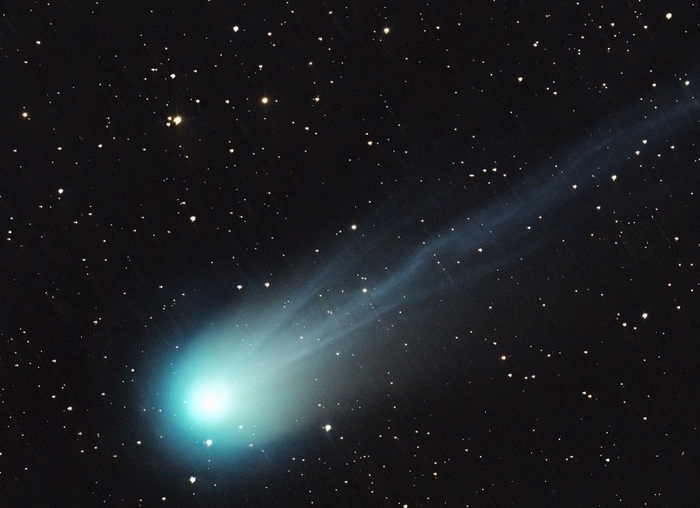Enlarge image
Green dot: Comet C/2022 E3 (ZTF) in the sky over Drebber, Lower Saxony
Photo: Thomas Lindemann / dpa
When comet C/2022 E3 (ZTF) last flew towards earth, the Neanderthals were still alive.
At the beginning of February it will once again reach its closest point to the earth.
It will then still be around 42 million kilometers away - almost a third of the distance between Earth and the Sun.
Comets come from the extreme and frigid edge of the solar system.
They are left over from the formation of the planets and consist of dust grains, organic molecules and - because of their low temperature - frozen gases.
The high proportion of volatile matter distinguishes them from asteroids.
They are sometimes pushed out of their original orbit by gravity or collisions and then also come close to Earth.
Only discovered last year
According to the German Aerospace Center (DLR), ZTF is around one kilometer in size, but currently has a coma around 50,000 kilometers in size, a kind of particle shell.
This occurs when the comet approaches the sun and heats up, causing particles to break loose from its ice and migrate into the tail.
The name ZTF is short for "Zwicky Transient Facility," which is the name of a program at the Palomar Observatory in California that discovered the comet last year.
From the orbit of the celestial body it can be calculated that it must have last passed the earth almost 50,000 years ago.
Good observation periods - if the weather cooperates - are the last days of January and the second half of February, when less moonlight brightens the sky.
January 21st and February 20th is the new moon.
While most comets can only be observed with good telescopes, ZTF can be seen with large binoculars.
At the beginning of the month, ZTF is still close to the polar star.
It then moves south, passing Capella, the carter's bright yellowish main star, on February 6th.
Four days later, ZTF will pass Mars and reach the orange Aldebaran in the constellation Taurus on February 15.
Mars, Jupiter, Venus in the night sky
But the comet is not the only sky spectacle in February.
In that month, three bright planets will be visible in the evening sky before it gets really dark.
High in the western sky stands Mars, Earth's outer planet neighbor, in a yellowish-reddish glow.
During the first week of February, the planet transits eight degrees north of orange Aldebaran, the main star of Taurus.
Far to the west, Jupiter shines in the constellation of Pisces.
In mid-February it passes through the northeast corner of the constellation Cetacean.
Jupiter sets earlier and earlier, at the end of the month shortly before 9:00 p.m.
Venus, our inner neighbor planet, shines just above the southwestern horizon in February.
There is a spectacular view of the sky on Ash Wednesday: around 7 p.m. on February 22, the narrow crescent of the waxing moon between Venus and Jupiter can be seen in the western evening sky.
Both planets are easy to distinguish: Venus is significantly brighter than Jupiter.
koe/dpa




/cloudfront-eu-central-1.images.arcpublishing.com/prisa/4RITWNCKAZFB3I3MBXYYKH6YDI.jpg)









